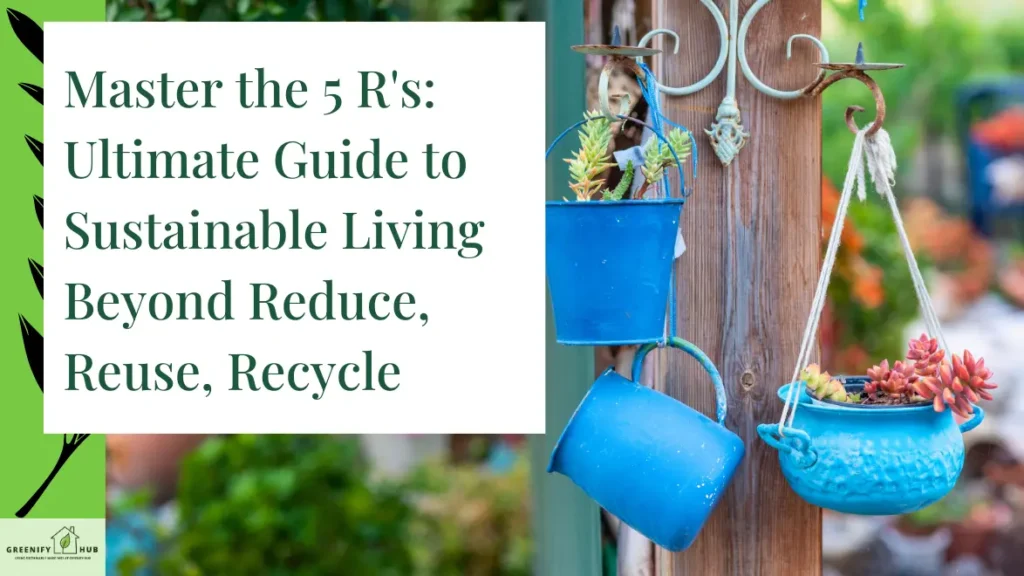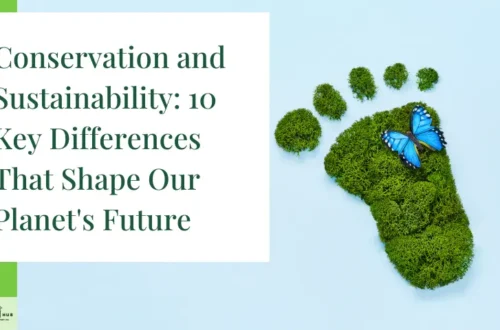Master the 5 R’s: Ultimate Guide to Sustainable Living Beyond Reduce, Reuse, Recycle

Imagine a world where every action we take contributes to a healthier planet. That’s the essence of sustainable living, and it all starts with the 5 R’s.
But what exactly are these 5 R’s?
They’re the golden arrows pointing us towards a zero-waste lifestyle: Refuse, Reduce, Reuse, Repurpose, and Recycle.
- Refuse: The first step in reducing waste
- Reduce: Minimizing your environmental footprint
- Reuse: Extending the life of products
- Repurpose: Giving items a new life
- Recycle: The last resort in waste management
These principles aren’t just fancy words. They’re practical steps we can all take to minimize our environmental impact.
Think of the 5 R’s as a roadmap. Each ‘R’ represents a different route we can take to reduce waste and live more sustainably.
Refuse is about saying ‘no’ to unnecessary items. Reduce focuses on cutting down our consumption. Reuse encourages us to get creative with what we already have. Repurpose gives items a new lease on life. And Recycle? It’s our last resort when all else fails.
By embracing these principles, we’re not just reducing waste. We’re reshaping our relationship with the world around us.
Ready to dive deeper? Let’s explore each ‘R’ and discover how they can transform our daily lives.
The 5 R’s of sustainable living – Refuse, Reduce, Reuse, Repurpose, and Recycle – provide a practical framework for minimizing waste and environmental impact in our daily lives.
Refuse: The First Step to Reducing Waste
Refuse is the first principle of zero waste living, and it’s simpler than you might think. It’s all about saying ‘no’ to things we don’t need.
Imagine you’re at a store checkout. The cashier offers you a free plastic bag. That’s your chance to refuse! By bringing your own reusable bag, you’ve just prevented another single-use item from entering the waste stream.
But it’s not just about bags. Think about all the unnecessary items we’re offered daily:
– Free promotional pens at events
– Straws with your drinks
– Junk mail in your letterbox
Each time we refuse these items, we’re taking a small but significant step towards reducing waste.
Remember, the best way to manage waste is to not create it in the first place. By refusing unnecessary items, we’re tackling the problem at its source.
Refusing unnecessary items is the crucial first step in waste reduction, preventing single-use and unwanted products from entering our lives and the waste stream.
Practical Tips for Refusing in Daily Life
Incorporating ‘refuse’ into your daily life doesn’t have to be daunting. Here are some practical tips:
1. Say no to freebies: Those free pens and keychains? Politely decline.
2. Opt out of junk mail: Use online services to remove your address from mailing lists.
3. Bring your own: Carry reusable shopping bags, water bottles, and coffee cups.
4. Choose digital: Opt for e-tickets and digital receipts instead of paper ones.
5. Be prepared: Keep a “refuse kit” with reusable items in your car or bag.
Remember, every refusal is a win for the environment. It might feel awkward at first, but it soon becomes second nature.
Implementing ‘refuse’ in daily life involves being prepared with reusable alternatives and confidently saying no to unnecessary items.
Reduce: Minimizing Your Environmental Footprint
Reduce is all about cutting down on what we use and consume. It’s the next logical step after refuse in our journey towards sustainable living.
Think about your daily routine. How many items do you use that could be reduced?
Maybe it’s the amount of water you use while brushing your teeth. Or the energy consumed by leaving appliances on standby. Each reduction, no matter how small, contributes to lessening our negative impact on the environment.
Here’s a startling fact: The average American generates about 4.9 pounds of waste per day. Imagine if we all committed to reducing that by just 10%!
Reducing isn’t about depriving ourselves. It’s about being mindful of our consumption and making conscious choices. It’s asking ourselves, “Do I really need this?” before making a purchase.
By reducing, we’re not just minimizing waste. We’re also:
– Conserving natural resources
– Reducing pollution from production and transportation
– Saving money on unnecessary purchases
Remember, the goal isn’t perfection. It’s progress. Every small reduction adds up to make a big difference.
Reducing our consumption is a powerful way to minimize waste output and negative environmental impact, involving mindful decision-making in our daily lives.
Strategies for Reducing Consumption
Ready to start reducing? Here are some effective strategies:
1. Plan your meals: This reduces food waste and unnecessary purchases.
2. Embrace minimalism: Focus on essential purchases only.
3. Go digital: Replace physical items with digital versions where possible.
4. Energy-efficient choices: Replace household lights with LED bulbs.
5. Buy in bulk: This reduces packaging waste for items you use frequently.
6. Quality over quantity: Invest in durable items that last longer.
7. Borrow or rent: For items you only need occasionally.
Remember, reducing is about making conscious choices. Start small and build from there.
Implementing strategies like meal planning, minimalism, and energy-efficient choices can significantly reduce our daily consumption and waste output.
Reuse: Extending the Life of Products
Reuse is all about getting creative and extending the life of items we already own. It’s a powerful way to reduce waste and conserve resources.
Think about that glass jar you’re about to toss in the recycling bin. Could it be washed and used to store leftovers? Or how about that old t-shirt? It could become a handy cleaning rag.
Reusing isn’t just about finding new uses for old items. It’s also about choosing reusable alternatives to single-use products. For instance:
– Swap paper towels for washable cloth napkins
– Use a reusable water bottle instead of buying bottled water
– Opt for rechargeable batteries over disposable ones
By reusing, we’re not just reducing waste. We’re also:
– Saving money on new purchases
– Reducing the energy and resources needed to produce new items
– Fostering creativity as we find new uses for old things
Remember, every time we reuse an item, we’re giving it a new lease on life and keeping it out of the landfill.
Reusing items extends their life, reduces waste, and promotes resourcefulness, offering both environmental and economic benefits.
Creative Ways to Reuse Everyday Items
Let’s get creative! Here are some innovative ways to reuse common household items:
1. Glass jars: Use as storage containers or candle holders
2. Cardboard boxes: Transform into organizers or cat scratching posts
3. Old clothes: Cut into cleaning rags or sew into reusable shopping bags
4. Plastic containers: Repurpose as planters or organizers
5. Wine corks: Create a bulletin board or coasters
6. Newspaper: Use as gift wrap or to clean windows
7. Empty tin cans: Paint and use as pencil holders or flower pots
Remember, the only limit is your imagination! Get the whole family involved and make it a fun project.
Everyday household items can find new life through creative reusing, turning potential waste into useful objects.
Repurpose: Giving Items a New Life
Repurposing takes reusing to the next level. It’s about transforming an item into something completely different, often with an entirely new function.
Imagine an old ladder becoming a bookshelf, or a vintage suitcase turning into a quirky side table. That’s repurposing in action!
This practice isn’t just eco-friendly; it’s also a fantastic way to express your creativity. It allows you to:
– Create unique, one-of-a-kind items
– Save money on new purchases
– Reduce the amount of waste going to landfills
– Preserve the sentimental value of old objects
Repurposing can be as simple as using scrap paper for notes, or as complex as turning an old bathtub into a garden planter.
The beauty of repurposing is that it challenges us to see the potential in every object. It’s about looking at that broken chair and seeing a future garden trellis.
Remember, when you repurpose, you’re not just giving an item a new life. You’re also telling a story and creating something truly unique.
Repurposing transforms items into new, functional objects, combining creativity with waste reduction and resource conservation.
Upcycling Ideas for Common Household Objects
Ready to give repurposing a try? Here are some inspiring ideas:
1. Wine bottles: Turn them into beautiful vases or candle holders
2. Old doors: Repurpose as a rustic headboard or dining table
3. Mason jars: Transform into pendant lights or bathroom organizers
4. Wooden pallets: Create outdoor furniture or vertical gardens
5. Broken china: Use pieces to create mosaic art or jewelry
6. Old tires: Repurpose as garden planters or outdoor ottomans
7. Vintage suitcases: Convert into unique storage solutions or pet beds
Remember, the goal is to see potential in every object. Let your creativity run wild!
Upcycling common household objects into new, functional items combines creativity with sustainable living practices.
Recycle: The Last Resort in Waste Management
Recycling is often seen as the poster child for environmental responsibility. But in the world of sustainable waste management, it’s actually our last resort.
Why? Because recycling still requires energy and resources. It’s better than landfill, but not as good as refusing, reducing, or reusing.
Think of recycling as your safety net. When you can’t refuse, reduce, reuse, or repurpose, that’s when recycling steps in.
But don’t underestimate its importance! Recycling helps:
– Conserve natural resources
– Reduce greenhouse gas emissions
– Save energy in manufacturing
– Create jobs in the recycling and manufacturing industries
To recycle effectively:
1. Know your local recycling guidelines
2. Clean items before recycling
3. Separate different materials
4. Avoid wishcycling (putting non-recyclable items in the recycling bin)
Remember, not everything that seems recyclable actually is. Always check the recycling symbol and follow appropriate recycling guidelines.
While recycling is a crucial part of waste management, it should be seen as a last resort after refusing, reducing, reusing, and repurposing.
Understanding Different Types of Recyclable Materials
Knowing what can be recycled is crucial. Here’s a quick guide:
1. Paper products: Most paper and cardboard can be recycled, but avoid greasy or food-stained items
2. Plastics: Look for the recycling symbol. Not all plastics are recyclable
3. Glass: Most glass containers can be recycled, but not window glass or mirrors
4. Metals: Aluminum cans, steel cans, and most scrap metal are recyclable
5. Electronics: Many components can be recycled, but require special handling
6. Textiles: Some areas offer textile recycling for clothes and fabrics
Always check with your local recycling center for specific guidelines. The United States Environmental Protection Agency also provides comprehensive recycling information.
Understanding the different types of recyclable materials and local guidelines is essential for effective recycling practices.
Rot: Composting Organic Waste
Composting is nature’s way of recycling. It’s the process of turning organic waste into nutrient-rich soil. Think of it as the ultimate form of recycling for food scraps and yard waste.
Why compost? It’s a sustainable campus practice that:
– Reduces landfill waste
– Creates free, nutrient-rich soil for gardens
– Lowers greenhouse gas emissions from landfills
– Improves soil structure and water retention
Composting can be done on any scale, from a small kitchen bin to a large backyard pile. You can compost:
– Fruit and vegetable scraps
– Coffee grounds and tea bags
– Eggshells
– Yard trimmings
– Leaves and grass clippings
Remember, composting isn’t just for those with gardens. Many communities offer composting programs, and some apartment dwellers use worm bins for indoor composting.
By composting, you’re completing the natural cycle of growth, decay, and rebirth. It’s a beautiful way to give back to the earth.
Composting is an eco-friendly method of recycling organic waste, reducing landfill use while creating nutrient-rich soil for gardens.
Implementing the 5 R’s in Business Practices
Businesses play a crucial role in promoting sustainable living. Implementing the 5 R’s can lead to significant reductions in a business’s waste output and improve its environmental footprint.
Here’s how businesses can incorporate the 5 R’s:
1. Refuse: Say no to unnecessary purchases and single-use items
2. Reduce: Minimize energy consumption and paper use
3. Reuse: Encourage the use of reusable office supplies
4. Repurpose: Find new uses for old equipment or furniture
5. Recycle: Set up comprehensive recycling programs
When planning events, consider sustainable options like:
– Digital invitations instead of paper
– Reusable decorations
– Compostable or recyclable dining ware
Remember, sustainable practices aren’t just good for the environment. They can also improve a company’s image and bottom line.
By adopting these practices, businesses can lead by example and inspire their employees and customers to embrace sustainable living.
Businesses can significantly reduce their environmental impact by implementing the 5 R’s in their daily operations and event planning.
The Impact of the 5 R’s on Energy Conservation
The 5 R’s don’t just reduce waste – they’re also powerful tools for energy conservation. Every time we refuse, reduce, reuse, repurpose, or recycle, we’re saving energy.
How? Let’s break it down:
– Refusing and reducing mean less energy used in production and transportation
– Reusing and repurposing eliminate the need for new items, saving manufacturing energy
– Recycling often uses less energy than producing from raw materials
Simple actions can have a big impact. For instance, replacing household lights with energy-efficient bulbs can significantly reduce electricity consumption.
Remember, energy conservation is like a golden arrow pointing towards a more sustainable future. Every kilowatt-hour saved is a step in the right direction.
Implementing the 5 R’s not only reduces waste but also contributes significantly to energy conservation, making it a comprehensive approach to sustainable living.
Overcoming Challenges in Adopting a Zero-Waste Lifestyle
Transitioning to a zero-waste lifestyle can seem daunting. It’s normal to face challenges along the way. But remember, every small step counts!
Common challenges include:
1. Convenience: Zero-waste options aren’t always readily available
2. Cost: Some sustainable alternatives may seem more expensive initially
3. Habits: Changing long-standing routines can be difficult
4. Social pressure: Not everyone may understand or support your choices
To overcome these challenges:
– Start small: Begin with one area of your life, like your kitchen or bathroom
– Plan ahead: Carry reusable items to avoid single-use products
– Educate yourself: Learn about the environmental impact of your choices
– Find a community: Connect with others on the same journey for support and ideas
Remember, perfection isn’t the goal. Every effort to reduce waste makes a difference. Celebrate your progress, no matter how small!
While adopting a zero-waste lifestyle can present challenges, starting small, planning ahead, and finding community support can help overcome these obstacles.
The Future of Sustainable Waste Management
The world of sustainable waste management is evolving rapidly. As we become more aware of our environmental impact, innovative solutions are emerging.
Some exciting developments include:
1. AI-powered recycling systems that can sort waste more efficiently
2. Biodegradable packaging materials made from algae or mushrooms
3. Zero-waste grocery stores gaining popularity
4. Cities implementing comprehensive composting programs
The next step? It could be a circular economy where waste is eliminated, and resources are continually reused.
As individuals, our role is to stay informed, adapt to new practices, and continue pushing for more sustainable solutions.
Remember, the future of waste management isn’t just about technology. It’s about changing our mindset and lifestyle choices.
The future of sustainable waste management involves innovative technologies and a shift towards a circular economy, with individual choices playing a crucial role.
The Role of Community in Promoting Sustainable Living
Sustainable living isn’t a solo journey. It thrives on community support and collective action.
Consider your college community. From students to the vice president, everyone can play a part in promoting sustainable practices.
Here’s how communities can make a difference:
1. Organize swap meets for reusing items
2. Start community composting programs
3. Host workshops on sustainable living
4. Implement recycling initiatives in public spaces
5. Support local businesses with sustainable practices
Remember, change often starts small but can spread quickly within a community. Your actions can inspire others and create a ripple effect of positive change.
By working together, we can create a culture of sustainability that extends far beyond individual efforts.
Community involvement is crucial in promoting and sustaining eco-friendly practices, creating a collective impact greater than individual efforts.
Measuring Your Progress in Sustainable Living
Tracking your progress is key to maintaining motivation and identifying areas for improvement in your sustainable living journey. There are several ways you can measure your impact and progress towards sustainable living:
1. Keep a sustainability journal: Record your daily actions, choices, and the impact they have on the environment.
2. Monitor your waste production: Keep track of your trash output and strive to reduce it over time.
3. Calculate your carbon footprint: Use online calculators to understand your carbon emissions and find ways to lower them.
4. Set sustainability goals: Establish specific targets for reducing waste, conserving energy, or supporting eco-friendly practices.
5. Participate in sustainability challenges: Join initiatives or challenges that encourage sustainable living habits and provide accountability.
Remember, progress is not always linear, and it’s okay to have setbacks. What matters most is your ongoing commitment to making a positive difference in the world through your sustainable lifestyle choices. Keep challenging yourself, celebrating your successes, and learning from your experiences to continue evolving towards a more sustainable future.
Tracking and measuring your sustainability efforts are essential for staying motivated and continuously improving your environmental impact. Set goals, monitor your progress, and celebrate your achievements along the way.
Conclusion
As we wrap up our journey through the 5 R’s of sustainable living, it’s clear that these principles offer a comprehensive framework for reducing our environmental impact. By embracing Refuse, Reduce, Reuse, Repurpose, and Recycle, we can significantly minimize waste and conserve precious resources. Remember, sustainable living is not about perfection but progress. Every small step, from refusing single-use items to composting organic waste, contributes to a healthier planet.
Implementing these practices in our daily lives and businesses can lead to transformative changes. As we’ve explored, the benefits extend beyond waste reduction to energy conservation and community building. By measuring our progress and overcoming challenges together, we pave the way for a more sustainable future.
Thank you for reading our article. Let’s continue to innovate, inspire, and act responsibly. The power to create a sustainable world lies in our hands – let’s make every choice count!





